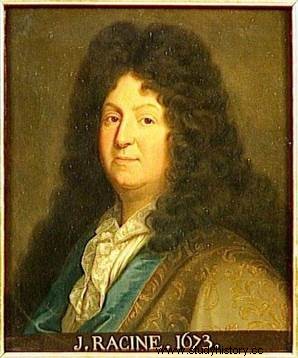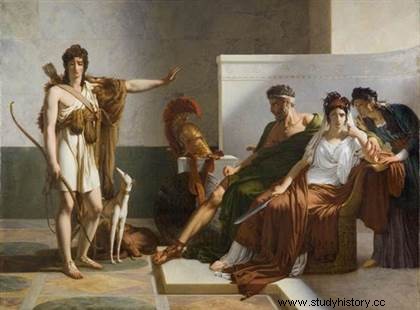 Jean Racine (1639-1699) was a French playwright of the 17th century, and was one of the most significant authors of the century of Louis XIV, along with Pierre Corneille and Molière. . After trying to reconcile his literary aspirations with an ecclesiastical career, he devoted himself entirely to the theater. He is famous for his classical tragedies inspired in particular by the great figures of Greek mythology:Andromaque (1667), Iphigenia (1674) or Phèdre (1677). Racine paints the disastrous victory of the Passions over Reason and casts on the boards tormented heroes doomed to destroy themselves and unable to escape their destiny imposed by divine forces.
Jean Racine (1639-1699) was a French playwright of the 17th century, and was one of the most significant authors of the century of Louis XIV, along with Pierre Corneille and Molière. . After trying to reconcile his literary aspirations with an ecclesiastical career, he devoted himself entirely to the theater. He is famous for his classical tragedies inspired in particular by the great figures of Greek mythology:Andromaque (1667), Iphigenia (1674) or Phèdre (1677). Racine paints the disastrous victory of the Passions over Reason and casts on the boards tormented heroes doomed to destroy themselves and unable to escape their destiny imposed by divine forces.
The Jansenist education of Jean Racine
Born on December 22, 1639 in La Ferte-Milon, Jean Racine was orphaned at the age of four and was raised by the nuns of the Petites Écoles of Port Abbey. -Royal-des-Champs. He was a pupil of the Jansenists until 1658 and will remain very marked by their rigorous and pessimistic vision of the Faith.
 The Jansenists indeed consider that man is a sinner, attracted by evil and that he cannot know redemption only in another life and only if he is chosen by God for it (good deeds alone are not enough). The schools of Port-Royal were then among the best schools in the Kingdom, so Jean Racine received a high quality education, it was there that he was introduced to literature and ancient culture.
The Jansenists indeed consider that man is a sinner, attracted by evil and that he cannot know redemption only in another life and only if he is chosen by God for it (good deeds alone are not enough). The schools of Port-Royal were then among the best schools in the Kingdom, so Jean Racine received a high quality education, it was there that he was introduced to literature and ancient culture.
A hyperbolic literary career
After leaving the Jansenist schools, Jean Racine led a social life in Paris (1658 – 1661) and tried his hand at poetry. Worried, his family sent him to Uzès in the hope that he would obtain an ecclesiastical benefice. It was a failure and in 1663 he returned to Paris where he began his career as a playwright:he had his first two plays performed:La Thébaïde and Alexander . Gradually, he fell out with his Jansenist friends while his dramaturgical career was confirmed:between 1667 and 1677 he had eight tragedies performed (Andromaque , Britannicus , Bérénice , Bajazet , Mithridates , Iphigenia in Aulide and Phèdre )!
Noted by King Louis XIV for his odes (Ode to the Nymph of the Seine , Ode on the convalescence of the King ), he obtains his protection and tends to erase his rival, Corneille, at court. The climate is then very tense between the different playwrights, in particular between Racine and the troupe of Molière. He was elected to the French Academy in 1673. A courtier living in the entourage of the sovereign, Jean Racine had a tumultuous private life, becoming the lover of his two favorite performers:Du Parc and Mademoiselle de Champmeslé.
In 1677 he was the object of a cabal against his play Phèdre , Racine then gave up the theater. This year marks a profound change in the life of the playwright:he is appointed historiographer by the King, he marries the granddaughter of a Parisian notary and leads a bourgeois life marked by a return to Jansenism which is characterized by austere piety. His last plays (Esther and Athalie ) are plays of biblical tragedies commissioned by the devout companion of the King:Mme de Maintenon. He also writes Spiritual Songs and a Summary of the history of Port-Royal before giving up his soul at the twilight of the century (April 21, 1699).
He leaves a work dominated by the description of human passions gnawing at individuals until death and by the idea of tragic destiny imposed by divine forces.
The Racinian tragedy
The Racinian tragedy is inspired by ancient authors (Euripides, Virgil, Tacitus, Suetonius...) freely exploited to treat great frescoes of mythology, history ancient Greco-Roman, biblical, even oriental. In classical tragedy, written in alexandrines, the three unities are respected (unity of time, place and action), the adventures are probable, the heroes are nobles, driven by the gods to a destructive passion.
To put an end to this destructive passion (often Love), the tragic hero seeks to destroy the object of his passion and he destroys himself at the same time. The outcome is therefore necessarily disastrous and finished in blood. However, it is necessary to qualify, because Racine does not systematically cause his heroes to physically die. Thus, he writes in the preface to Bérénice :"it is not necessary that there be blood and death in a tragedy:it is enough that the action is great, that the actors are heroic, that the passions are excited there, and that everything is felt there of this majestic sadness which makes all the pleasure of the tragedy .
The style of Jean Racine's works highlights the tragedy of the human condition, the individual appearing as the plaything of a passionate, irresistible and destructive love that drives him away moral precepts. Whatever he does, the Racinian hero runs to his loss, he has no control over his own life and follows his disastrous destiny (a pessimistic vision marked by Jansenism).
From Act I, violent passions lead to a chain reaction, a rise in tension, a death march that generally seems to be avoidable only at 'Act IV... Mad hope that does not materialize in Act V. The tragic register is characteristic of certain lexical fields:that of the family, of blood, of fatality, of love and of death. Similarly, tragic discourse includes many figures of speech:hyperboles, antitheses, parallelisms, oxymorons...
From a formal point of view, Jean Racine does not upset the rules of tragedy, he is distinguished by a perfect mastery of language and his great ability to make the audience feel reader / viewer intense emotions while respecting the constraining framework of classical tragedy.
Main works of Racine
- Andromache, 1667
- Britannicus, 1669
- Berenice, 1670
- Iphigenia, 1674
- Phaedrus, 1677
Bibliography
- Jean Racine, biography of Georges Forestier. Gallimard, 2006.
- ETERSTEIN Claude (sdd), French literature from A to Z, Hatier, 2011.

